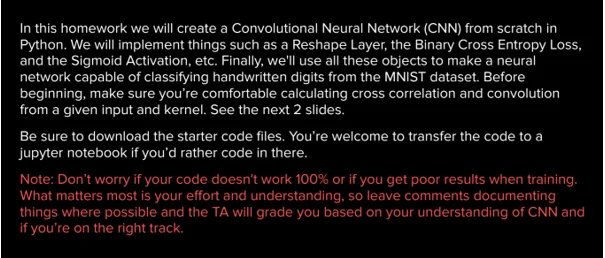Instructions
ObjectiveWrite a program to implement cross entropy in python.
Requirements and Specifications

Source Code
import numpy as np
from keras.datasets import mnist
from keras.utils import np_utils
from dense import Dense
from softmax import Softmax
from convolutional import Convolutional
from reshape import Reshape
from activations import Tanh, Sigmoid
from losses import binary_cross_entropy, binary_cross_entropy_prime
def preprocess_data(x, y, limit):
'''
Will limit our data since using the whole thing will take forever on a cpu especially since we're
implementing this from scratch.
'''
x = x.reshape(len(x), 1, 28, 28)
x = x.astype("float32") / 255
y = np_utils.to_categorical(y)
y = y.reshape(len(y), 10, 1)
return x[:limit], y[:limit]
# load MNIST from server, limit to 100 images per class since we're not training on GPU
(x_train, y_train), (x_test, y_test) = mnist.load_data()
x_train, y_train = preprocess_data(x_train, y_train, 100)
x_test, y_test = preprocess_data(x_test, y_test, 100)
# TODO: Add our layers and the flow of input into this list.
network = [
Convolutional((1, 28, 28), 3, 5),
Sigmoid(),
Reshape((5, 26, 26), (5 * 26 * 26, 1)),
Dense(5 * 26 * 26, 100),
Sigmoid(),
Dense(100, 100),
Sigmoid(),
Dense(100, 10),
Softmax()
]
epochs = 100
learning_rate = 0.1
#train
for e in range(epochs):
error = 0
for x, y in zip(x_train, y_train):
# forward
output = x
for layer in network:
output = layer.forward(output)
# TODO: update our error
error += binary_cross_entropy(y,output)
grad = binary_cross_entropy_prime(y,output)
# TODO: perform back prop
for layer in reversed(network):
grad = layer.backward(grad,learning_rate)
error /= len(x_train)
print(f"{e + 1}/{epochs}, error={error}")
# TODO: run the test data through and print out your predictions
for x, y in zip(x_test, y_test):
output = x
for layer in network:
output = layer.forward(output)
print(f"y_pred: {np.argmax(output)}, y_true: {np.argmax(y)}")
Similar Samples
At Programming Homework Help, we offer a wide range of sample solutions to showcase our expertise in various programming languages. Our detailed and well-commented code examples serve as a testament to our commitment to quality and precision, helping you understand complex concepts effortlessly.
Python
Python
Python
Python
Python
Python
Python
Python
Python
Python
Python
Python
Python
Python
Python
Python
Python
Python
Python
Python